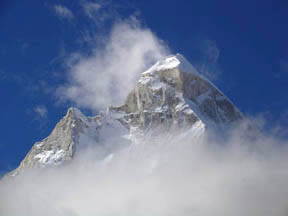
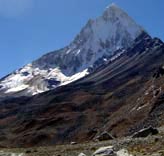 Summer's
Monsoon still firmly enforced its presence throughout our Indian travel, all
the way up & into the high valleys of Garhwal's Himalaya. From the plains our
expedition traversed to the River Ganga (Ganges) and followed it upstream to
the glacial source: A very special Hindu pilgrimage. Their destination the
glacier's snout, source of the river's flow "Gaumukh" (Cow's Mouth): Bathe and
return home with a bottled memento or perhaps travel further; onto the
Gangotri glacier and up to its first alpine meadow Topovan, immediately
beneath Shivling. Ganga
has remained in the Indian psyche as the ultimate source of attaining nirvana
and every important place along the Ganga has become major pilgrimage centres
for millions of Hindus. Gangotri is the place where the Ganga is believed to
have descended on earth.
Summer's
Monsoon still firmly enforced its presence throughout our Indian travel, all
the way up & into the high valleys of Garhwal's Himalaya. From the plains our
expedition traversed to the River Ganga (Ganges) and followed it upstream to
the glacial source: A very special Hindu pilgrimage. Their destination the
glacier's snout, source of the river's flow "Gaumukh" (Cow's Mouth): Bathe and
return home with a bottled memento or perhaps travel further; onto the
Gangotri glacier and up to its first alpine meadow Topovan, immediately
beneath Shivling. Ganga
has remained in the Indian psyche as the ultimate source of attaining nirvana
and every important place along the Ganga has become major pilgrimage centres
for millions of Hindus. Gangotri is the place where the Ganga is believed to
have descended on earth.
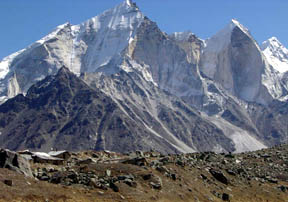 Our
intended camp lay beyond Topovan yet we opted for a couple of
days acclimatizing, bouldering and the company of Conrad Anker, Bruce Miller
& Doug Chabot before auguring into our own base-encampment.
Travelling under an
eternal grey ceiling kept all vistas veiled until Topovan's breathtaking cloud
lift. Rime ice cloaked the Bhagirathi group and Shiviling's conical form after
such prolonged, incessant weather. The American trio's hopes rose with the
frowning cloud's that had darkened their entire stay and quest for Meru's
Shark Fin. Tardy arrival of the year's monsoon created many problems for
India's population, its lingering proved the same for climbers in
greatly foreshortening the "Post-Monsoon" weather window. Another unfortunate
and temporary side effect of travelling to Asia's mountains always seems to
be loss of appetite for Rice & Curry dishes: Usually a personal
favourite but
too much is just that, specially after the inevitable violent ejection from
one's body; at least once per-trip? Unfortunately companions Mark Synnott and
Cameron Lawson were suffering but recovering from their intestinal demons yet
still managed to enjoy 'world-class' granite bouldering in Topovan meadow. So
good I know a couple of folk who have made the journey with no intent
beyond boulders.
Our
intended camp lay beyond Topovan yet we opted for a couple of
days acclimatizing, bouldering and the company of Conrad Anker, Bruce Miller
& Doug Chabot before auguring into our own base-encampment.
Travelling under an
eternal grey ceiling kept all vistas veiled until Topovan's breathtaking cloud
lift. Rime ice cloaked the Bhagirathi group and Shiviling's conical form after
such prolonged, incessant weather. The American trio's hopes rose with the
frowning cloud's that had darkened their entire stay and quest for Meru's
Shark Fin. Tardy arrival of the year's monsoon created many problems for
India's population, its lingering proved the same for climbers in
greatly foreshortening the "Post-Monsoon" weather window. Another unfortunate
and temporary side effect of travelling to Asia's mountains always seems to
be loss of appetite for Rice & Curry dishes: Usually a personal
favourite but
too much is just that, specially after the inevitable violent ejection from
one's body; at least once per-trip? Unfortunately companions Mark Synnott and
Cameron Lawson were suffering but recovering from their intestinal demons yet
still managed to enjoy 'world-class' granite bouldering in Topovan meadow. So
good I know a couple of folk who have made the journey with no intent
beyond boulders.
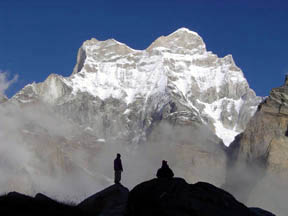 Sundovan
three hours 'up valley', the next meadow/bench hovering above the Gangotri
glacier shared little physical character with its namesake "Beautiful/Mystical
Forest" and was to be our base. The North ridge of 22600ft Kedar Dome rolls
right down to camp's plateau, the Bhagirathis loom across the Gangotri and
Shivling stands proud to the North beyond the Kirti glacier: Doubling its
summits viewed from the new southern aspect (image right). Kedar Dome's
previous trundling of perfect quartzite boulders onto a flat sandy wash behind
camp provided fun and exercise maintaining fitness during uncompromising
afternoon storms. Finest of the small stones was dubbed "The Five Star
Boulder" and would be big news if adjacent to any urban area, each passage a
multi stared classic, every landing flat sand; V0 to V8 and a remaining V11
project.
Sundovan
three hours 'up valley', the next meadow/bench hovering above the Gangotri
glacier shared little physical character with its namesake "Beautiful/Mystical
Forest" and was to be our base. The North ridge of 22600ft Kedar Dome rolls
right down to camp's plateau, the Bhagirathis loom across the Gangotri and
Shivling stands proud to the North beyond the Kirti glacier: Doubling its
summits viewed from the new southern aspect (image right). Kedar Dome's
previous trundling of perfect quartzite boulders onto a flat sandy wash behind
camp provided fun and exercise maintaining fitness during uncompromising
afternoon storms. Finest of the small stones was dubbed "The Five Star
Boulder" and would be big news if adjacent to any urban area, each passage a
multi stared classic, every landing flat sand; V0 to V8 and a remaining V11
project.
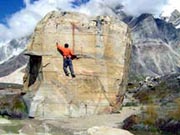
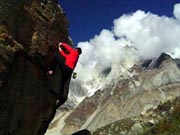
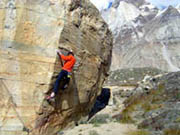
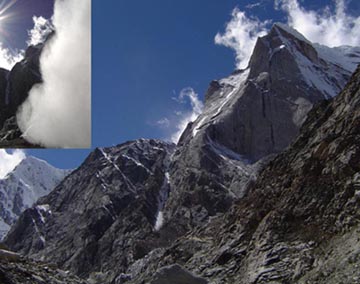 immediate
vicinity of Kedar Dome's East face?
immediate
vicinity of Kedar Dome's East face?
Devoid of energy from grovelling with sizable
loads snow flurries forced shelter and brought a very welcome break,
though short climbing day. Snow relented as wind reached worrying speeds then
dead calm, a clear brightly starred night sky. Morning sun quickly dispensed
yesterdays fresh fall but the cumulus gained strength early during the
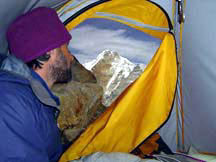 second
climbing day. By afternoon we were pinned by a fresh snow layer coating rock
pitches, again the flurries relented by evening. Repetitive storm syndrome
still remained localized to the ridge dividing Kedarnath's east & south faces:
Every day around eleven am the cumulus would build on the ridge dowsing
Kedarnath and Kedar Dome but nothing more? Day three on the climb daw
second
climbing day. By afternoon we were pinned by a fresh snow layer coating rock
pitches, again the flurries relented by evening. Repetitive storm syndrome
still remained localized to the ridge dividing Kedarnath's east & south faces:
Every day around eleven am the cumulus would build on the ridge dowsing
Kedarnath and Kedar Dome but nothing more? Day three on the climb daw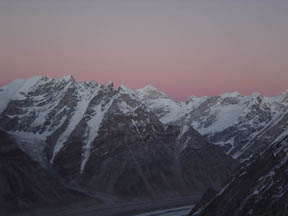 ned to
a murky sky, cloud filled and was showering by nine am. Only four pitches had
been possible the previous day, free climbing up to 5.9/5.10- with sparse
protection. Day three passed tent bound trying not to delve into food rations.
Day four offered little more promise, we stashed the tent, food & fuel at high
camp descended, leaving further equipment mainly rock gear, above the mixed
pitches at the first bivouac site. The idea was to re-supply food and wait for
a higher pressure weather system to force out daily storms. Snow early each
afternoon and the morning melt cycle minimized climbing time and frankly, we
needed more usable hours each day to pull off such a lengthy objective.
ned to
a murky sky, cloud filled and was showering by nine am. Only four pitches had
been possible the previous day, free climbing up to 5.9/5.10- with sparse
protection. Day three passed tent bound trying not to delve into food rations.
Day four offered little more promise, we stashed the tent, food & fuel at high
camp descended, leaving further equipment mainly rock gear, above the mixed
pitches at the first bivouac site. The idea was to re-supply food and wait for
a higher pressure weather system to force out daily storms. Snow early each
afternoon and the morning melt cycle minimized climbing time and frankly, we
needed more usable hours each day to pull off such a lengthy objective.
Afternoon build-up won the game a further week followed by a rise in barometric pressure, the highest thus far: All the signs needed to pack up and return to the climb.
The most violent of rime ice spraying storms
initiated as if triggered by arrival back to advanced base. Morning sun
succeeded its melting task as we returned up the ramps and mixed terrain, en
route with the mindset that we had to beat building clouds and gain the prior
high-point. Cumulus began fluffing the ridge as usual but without expected
vigour, receding instead of releasing in the afternoon. Regaining the prior
highpoint in a single climbing day boosted psyche: Leading was divided
into blocks instead of switching packs and racks each pitch. Front man proved
the easier task, jumaring beneath the 60-70lb pack was much more physi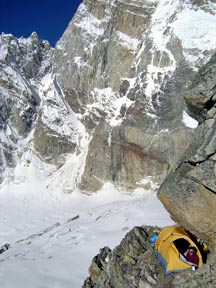 cal; absolutely draining
more like, yet we stayed in motion. Our second climbing day saw minimal cloud
building, the pattern had broken! Several hundred feet of simul climbing, two
steep rock pitches following good, protectable crack systems then a lengthy
traverse to a couloir/gully. Mark lead up the gully trailing our two ropes; a
60m, 10mm diameter lead rope and a skinny 7mm, also 60m. Mark placed a belay
and anchored the main rope on the right side of the gully removed his pack and
clipped it to the belay; he then continued up the remainder of the gully
trailing th
cal; absolutely draining
more like, yet we stayed in motion. Our second climbing day saw minimal cloud
building, the pattern had broken! Several hundred feet of simul climbing, two
steep rock pitches following good, protectable crack systems then a lengthy
traverse to a couloir/gully. Mark lead up the gully trailing our two ropes; a
60m, 10mm diameter lead rope and a skinny 7mm, also 60m. Mark placed a belay
and anchored the main rope on the right side of the gully removed his pack and
clipped it to the belay; he then continued up the remainder of the gully
trailing th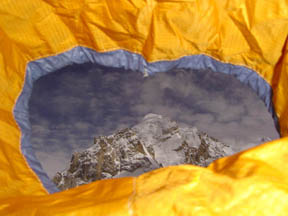 e
skinny rope while I jumared the 10mm up to the belay. The belay consisted of
three cams in what looked to be perfect cracks, I was walking up the snow
pulling on the rope for motive power, my full weight not upon the belay: Then
a moment of weightless-ness, first realization came as I rotated, head down
under the pack's mass, jumars flapping yet still attached to the now slack
rope, instinct without processing had me flip onto the pack in the hope its
odd shape would add friction and stop my slide. This worked, until Mark's pack
overtook my slithering form pulling further down slope. When the anchor failed
I fell left as the block that was the belay rolled down the right side.
Dramatics ceased, I was completely unscathed. Packs were clipped and being
hauled, Mark still apologizing, the blocks brief meeting point with our main
10mm rope was glaringly obvious. A fluffy white patch of protruding core; as
per "Murphy's Law" it was immediately beside the rope's half way mark. Three
and a half thousand feet lay beneath and the same above; the rope had put us
out of the race and could still make descent problematic. A bivouac was taken
atop the ridge and descent the following day.
e
skinny rope while I jumared the 10mm up to the belay. The belay consisted of
three cams in what looked to be perfect cracks, I was walking up the snow
pulling on the rope for motive power, my full weight not upon the belay: Then
a moment of weightless-ness, first realization came as I rotated, head down
under the pack's mass, jumars flapping yet still attached to the now slack
rope, instinct without processing had me flip onto the pack in the hope its
odd shape would add friction and stop my slide. This worked, until Mark's pack
overtook my slithering form pulling further down slope. When the anchor failed
I fell left as the block that was the belay rolled down the right side.
Dramatics ceased, I was completely unscathed. Packs were clipped and being
hauled, Mark still apologizing, the blocks brief meeting point with our main
10mm rope was glaringly obvious. A fluffy white patch of protruding core; as
per "Murphy's Law" it was immediately beside the rope's half way mark. Three
and a half thousand feet lay beneath and the same above; the rope had put us
out of the race and could still make descent problematic. A bivouac was taken
atop the ridge and descent the following day.
Weather shifted once more, firmly delivering
autumnal conditions. Cold (-20 to -30°C) clear nights, ground frost, a
chilling wind & shrunken climbing days. Having just enough equipment and
time for one quick challenge sights were trained upon Bhagirathi III's Scottish
pillar (right skyline, image below/right ).
Two thousand five hundred feet of granite topped by a slightly shorter shale
band: El Capitan capped by a Canadian Rockies peak. Lightning the load
by omitting the tent wasn't a
).
Two thousand five hundred feet of granite topped by a slightly shorter shale
band: El Capitan capped by a Canadian Rockies peak. Lightning the load
by omitting the tent wasn't a
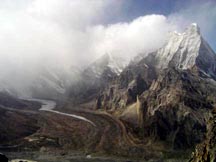 brilliant
idea worth it's four pounds in weight twice over, for projection and added
warmth. Bivouacked beneath the climb we had problems staying warm and a wall
of morning cloud effectively ended the venture (image left).
brilliant
idea worth it's four pounds in weight twice over, for projection and added
warmth. Bivouacked beneath the climb we had problems staying warm and a wall
of morning cloud effectively ended the venture (image left).
As with any trip to the mountains we came away much wiser and with intimate knowledge of all the Gangotri valley's remaining prizes. Several unclimbed 20000ft+ peaks and numerous walls remain for the future, not forgetting Kedar Dome's monolithic pillar.